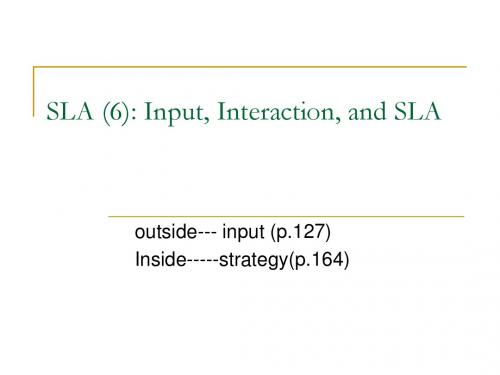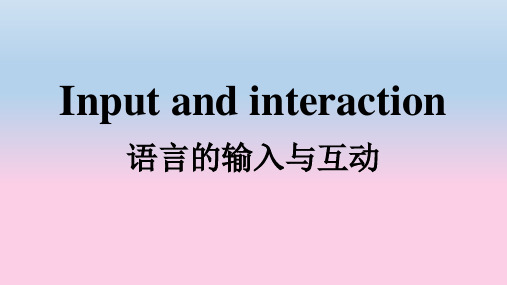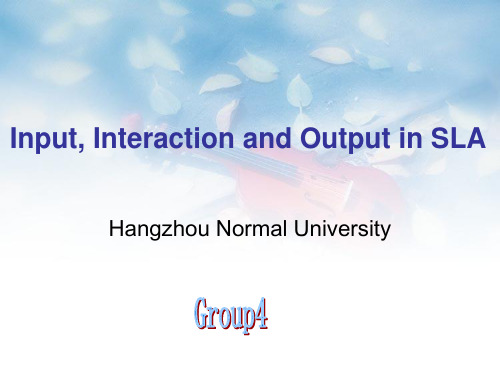Input, interaction and output
- 格式:pdf
- 大小:164.38 KB
- 文档页数:16



英语专业参考文献参考文献:1. Gass, S. M. (2012). Second language acquisition: An introductory course. Routledge.This comprehensive textbook provides an introduction to the field of second language acquisition (SLA). It covers the major theories and research findings in SLA, including language acquisition processes, individual differences, and the role of input, interaction, and feedback in language learning.2. Krashen, S. (1982). Principles and practice in second language acquisition. Pergamon Press.This book presents Krashen's influential theory of second language acquisition, which asserts that language acquisition occurs through natural exposure to comprehensible input. It discusses the theory's implications for second language teaching and provides practical advice for language teachers.3. Ellis, R. (2008). The study of second language acquisition (2nd ed.). Oxford University Press.This textbook offers a comprehensive overview of the field of second language acquisition. It covers topics such as language transfer, the role of explicit instruction, individual differences, and the development of communicative competence. The book also examines the relationship between SLA research and language teaching.4. Lightbown, P. M., & Spada, N. (2013). How languages are learned (4th ed.). Oxford University Press.This book provides an introduction to the field of second language acquisition for language teachers and students. It covers key topics such as the role of input, interaction, and output in language learning, as well as the influence of age, motivation, and individual differences on language acquisition.5. Larsen-Freeman, D. (2018). Research methods in language acquisition: Principles, procedures, and practices. John Wiley & Sons.This book provides a comprehensive guide to conducting research in the field of second language acquisition. It covers various research methods, including experimental studies, surveys, and case studies. The book also discusses ethical considerations and provides practical advice for designing and conducting research projects.6. Long, M. H., & Doughty, C. J. (Eds.). (2009). The handbook of language teaching. Wiley-Blackwell.This handbook offers a comprehensive overview of language teaching methods and approaches. It covers topics such as second language acquisition theory, curriculum design, materials development, and assessment. The book also explores the role of technology in language teaching.7. Nunan, D. (1999). Second language teaching & learning. Heinle & Heinle.This book provides an overview of the major approaches and methods in second language teaching. It covers topics such as communicative language teaching, task-based language teaching, and content-based instruction. The book also discusses issuesrelated to learner autonomy, motivation, and assessment in language learning.8. Brown, H. D. (2007). Principles of language learning and teaching (5th ed.). Pearson Longman.This textbook offers a comprehensive introduction to the principles of language learning and teaching. It covers topics such as second language acquisition theory, language teaching methods, classroom management, and assessment. The book also provides practical teaching tips and examples of effective language teaching techniques.Note: This list of references does not include links as requested.。


校园英语 /An Analysis on an ESL Class postgraduate of International Relations in Deakin University/Du Yueqing【Abstract】Input is the precondition of interaction and output while output promotes the input and the interaction of language,which could increase the effectiveness of input and enhance the chance of the absorption of interaction.By analyzing an ESL class,this paper gives readers a picture of how the second language (SL) learners get information,absorb and digest the information,produce language and form their language system in their SL learning.At last,it gives suggestions on how to ensure language learners have a better chance to get comprehensible input,assimilate language during interaction and output more accurate and comprehensible second language in an ESL class.【Key Words】ESL class; input; interaction; outputIntroduction of the ESL classRecorded by “Universal Institute of Technology”,which is a language institute,this class is an adult English as second language class (ESL) in the city of Melbourne.It is a class at the pre-intermediate level,which is comprised of a small group of the students,approximately 8.These students come from different countries and different backgrounds,namely Peru,Brazil,Italy,China and the majority of Korea,and do not have the same first language in common.Having been teaching them for about 5 months,the teacher Ms.Monique Sheldon-Stemm (Ms.Sheldon) focuses on how to talk about a special occasion by using two tenses,the past continuous tense and the simple past tense,to tell a story and she used four steps to achieve her teaching purpose.In the first step of the class,Ms.Sheldon gave a topic and brainstormed the students.The students had 2 minutes to think about the words and phrases that may be related to the topic.For the second step of the teaching procedure,the teacher asked the students to find a partner and talk about his/her own ideas,which would take another 2 minutes.What the students need to do during this period of time is to understand what his/her partner is speaking about his/her special occasion and try to help each other and improve by listening carefully.For the third step,the students were asked to think about how to make a proper sentence and then write down 2 sentences using their own words from brainstorming in 5 minutes.Ms.Sheldon didn’t forget to remind the students of tenses they should use for making their sentences.For step 4,she suggested the students check their sentences by reading aloud or asking someone else such as the teacher or partners to find whether the sentences are correct or not.The criterion was that if the sentences were understood,they were correct.Then each students need to tell their stories,“A Special Occasion” to their partners.Ms.Sheldon emphasized the word “tell”,which means when the students tell their stories,it is not reading but having a conversation with partners about their particular occasions.Then at last,the students would share the stories with the class.From the conversation in the class between the teacher and the students,people could find that the teacher always spoke in a soft voice and helped the students to correct sentences and answered their questions carefully and promptly.She was so patient with the students that repeated the instructions and questions again and again in order to avoid misunderstanding of the students and put a lot of emphasis of the students’ feedback in order to ensure whether they understood the requirements. Every student was asked to read the 2 sentences that they wrote loudly and told their stories to the class,which meant that each hadC) In a theater.D) In a restaurant.对于例4而言,难点在于Balcony一词,它本来是阳台的意思,与会话的内容没有太大关系,造成推理困难。

校园英语 / 高等教育研究浅析翻转课堂在大学英语教学中运用的利与弊江西工程学院/仇晨霞【摘要】我国社会主义市场经济的发展促进综合国力的提升,在与国际社会的经济贸易不断增加的过程中,对于英语专业人才的需求量也不断增加,从人才培养的角度考虑,大学英语教学中需要对学生的学科综合素养以及专业能力进行培养。
传统的课堂教学是老师为主导,学生在老师的带领下进行课程学习,这种教学模式影响学生的学习积极性和主动性,应用翻转课堂教学,则是对课程教学中老师和学生的课堂身份进行对换,使学生成为课堂主导,自主化的完成课程内容的学习。
但是对于翻转课堂在大学英语教学中应用的优势与劣势均要在实践分析中进行客观讨论,本篇文章在此基础上,主要对翻转课堂在大学英语教学中运用的利与弊进行研究与分析。
【关键词】翻转课堂 大学英语 课堂教学 利与弊 课程讲解大学英语教学主要是对学生的英语专业知识进行教学,与中学阶段的英语教学不同,学生不仅要对英语专业内容进行积累,同时要在实践应用中锻炼和提升自己的英语口语能力、听力能力和阅读写作能力等。
但是由于我国的大学英语课堂教学模式较为传统,仍旧是以教师课堂讲解为主,这种“一对多”形式的英语教学,使学生的课堂互动减少,且学生均需要在老师统一的思路下进行问题的思考、分析和研究,限制了学生学习探究能力的增长。
基于人才培养的考虑,我国大学英语课程教学中应用转变传统的思维模式,在教学手法和教学模式上积极创新改革,应用翻转课堂教学,使学生成为课堂的主导,在自我学习、自我分析和自我表达中检验和增强其英语实践能力。
一、翻转课堂在大学英语教学中运用的作用及优势1.提高教学资源利用率。
大学英语教学中应用翻转课堂能够在信息技术和网络平台的辅助下提高教学资源的利用率,学生能够最大限度的获取相关学习资料,短时间内获取有效学习信息的效率高。
大学英语教学中老师课堂讲解的内容有限,学生的学习被动,听课效率普遍不高,但是在翻转课堂教学中需要应用信息技术和网络设备,学生在网络上获取的英语学习资源丰富,包括在各种网络公开课的学习中学生能够掌握更多课本以外的英语知识,具有较强的学习补充作用。
现代语言学专业毕业论文选题参考二语习得中的语言输入与语言输出研究一、引言二语习得一直是语言学研究的热点之一,其中语言输入和语言输出作为习得的两个重要环节,一直备受关注。
本文旨在探讨二语习得中的语言输入与语言输出,并通过对相关研究进行综述,为现代语言学专业毕业论文选题提供参考。
二、语言输入与语言输出的定义与作用语言输入指的是学习者从外部环境中获取到的语言材料,包括听、读、观察等形式。
语言输出则是学习者通过口头或书面表达来表达自己的思想和意见。
语言输入和输出在二语习得中起着至关重要的作用,对于学习者的语言能力的提高具有决定性的影响。
三、语言输入对二语习得的影响1. 语言输入的丰富性与多样性对二语习得的促进作用语言输入的丰富性和多样性可以增加学习者获取语言信息的机会,提供更多的语言模型和语言样本,从而促进学习者掌握语言结构、词汇和语言规则的能力。
2. 语言输入的可理解性对二语习得的影响语言输入的可理解性指的是学习者能够对输入的语言材料理解的程度。
可理解的输入有助于学习者自主构建语言系统,更好地掌握语言知识和语言技能,并且能够激发学习者的自主学习兴趣。
四、语言输出对二语习得的影响1. 语言输出对语音习得的促进作用语言输出有助于学习者加强对语音语调的训练,提高语音表达的准确性,培养流利的口语能力。
2. 语言输出对词汇习得的促进作用通过语言输出,学习者可以巩固所学的词汇,提高词汇的掌握程度和使用能力,增加词汇的长时记忆和运用效率。
3. 语言输出对语法习得的促进作用语言输出能够帮助学习者反思和纠正自己的语法错误,增加语法的准确性和流利度。
五、二语习得中的语言输入与输出策略1. 创设语言输入环境提供丰富的语言输入资源,包括听音、阅读、观察等活动,创设真实场景和情景,帮助学习者接触到真实的语言使用情景。
2. 促进有效的语言输出通过交流、口头表达和书面表达等方式,鼓励学习者进行实践,提供反馈和指导,帮助学习者形成正确的语言使用习惯。
英语学习者的有效策略英语范文Effective Strategies for English Language Learners.Strategies for English Language Learners.As an English language learner, there are a number of effective strategies you can use to improve your language skills. These strategies can be divided into three main categories: input, output, and interaction.Input refers to the exposure you have to the English language. The more input you have, the more opportunities you have to learn new words and phrases, and to improve your understanding of grammar and syntax. Some effective input strategies include:Reading books, articles, and other texts in English.Listening to podcasts, music, and other audiocontent in English.Watching movies and TV shows in English.Output refers to the production of language. The more output you have, the more opportunities you have topractice using new words and phrases, and to improve your fluency and accuracy. Some effective output strategies include:Speaking and writing with native English speakers.Joining a conversation group or class.Participating in online forums or discussion boards.Interaction refers to the social aspect of language learning. The more interaction you have with native English speakers, the more opportunities you have to learn about the culture and to improve your communication skills. Some effective interaction strategies include:Making friends with native English speakers.Joining a social group or club.Volunteering in an English-speaking community.It is important to use a variety of strategies to improve your English language skills. By combining input, output, and interaction, you can create a well-rounded learning experience that will help you achieve your goals.中文回答:英语学习者的有效策略。
总第230期2013年1月(中)The Science Education Article CollectsTotal.230January 2013(B )摘要互动假说自1985年问世以来就受到广泛关注,现已成为二语习得界普遍认可的理论之一。
交际中的互动调整有助于语言输入的理解,输出是对输入的检验。
在二语习得中,输入、输出和互动三者密切相连。
对输入假说、输出假说进行分析,有助于更好地了解互动在二语习得过程中的作用,加深对互动假说理论的理解,把握其发展动向。
关键词二语习得输入假说输出假说互动假说An Analysis of the Interaction Hypothesis in SLA //Wang Miaomiao ,Kang GuangmingAbstract As one of the most widely acknowledged theories in second language acquisition at present ,the Interaction Hypoth -esis has been hotly debated since it came into being in 1985.Interaction facilitates comprehensible input resulted by means of interaction adjustments between learners and output tests the latter.Therefore ,three closely relevant factors ,namely in -put ,output are three essential compositing elements in secondlanguage acquisition.To understand the Interaction Hypothesisand the role of interaction in second language acquisition ,the analysis is also performed on the Input Hypothesis and the Output Hypothesis ,which might then guide the new trends of it.Key words second language acquisition ;Input Hypothesis ;Output Hypothesis ;Interaction Hypothesis1引言二语习得中,语言输入、互动和输出是三个密切相关的因素。
Comments on Input Hypothesis, Interaction Hypothesis and Output Hypothesis 1 Input HypothesisIn Input Hypothesis, Krashen claimed that exposure to comprehensible input was necessary for SLL to take place. To make it specific, suppose that a L2 learner’s current language level is i then the L2 acquisition automatically takes place when a leaner understands the input containing grammatical forms that are at i+1, which is a little more advanced than the current level of the leaner’s interlanguage. In general, what Krashen stresses are the comprehensibility of input and the natural acquisition of language. But, a great number of scholars has pointed out the problems existing in Input Hypothesis. Firstly, it does not distinguish input and interaction ignoring the function that interaction displays in L2 acquisition. Secondly, this hypothesis is difficult to prove and it takes the process that language acquisition device modifies learners’ interlanguage system for granted. What is more, there is no clear definition and explanation of the state i+1, and whether the i+1 formula can apply to all aspects of language including vocabulary and phonology as well as syntax remains unknown.2 Interaction HypothesisAs the Input Hypothesis had been doubted by more and more scholars, Michael Long put forward Interaction Hypothesis, which was a further supplement or extension of the Input Hypothesis in the field of SLA. Unlike the Input Hypothesis deals with one-way communication, Interaction Hypothesis follows the input-interaction-acquisition model, which is two-way communication. But it does recognize the significance of comprehensible input. Long held that the effectiveness of comprehensible input could be largely increased when language learners have to negotiate for meaning. That is, interactional modification can make input more comprehensible. The earlier studies were criticized for being too one-sidedly preoccupied with functional aspects of interaction and for neglecting linguistic theories. To further his study, Long introduced the notion of negative evidence which can help learners notice the gap in their interlanguage and the notion of selective attention for the sake of clarifying the process by which input becomes intake. InLong’s view, interaction functions when learners relate input, inner learning mechanism and output together by selective attention. Although the new version becomes more complete and objective, it still has limitations.Firstly, almost all interactionist research is carried out in western or Anglophone educational setting and more cross-cultural studies will be needed to make the results more convincing. Secondly, negotiation for meaning is only a small part of the learners’ all interactional activities, but Long’s Interaction Hypothesis is based on this single part, which makes the theory less universal. Actually, people only admit that interactional modifications can result in increased comprehension but whether increased comprehension can lead to increased acquisition or not remains in doubt. Besides, interactionist research pays more attention to interactional modifications, recasts and other processes in communication through which learners focus on meaning thus neglecting the specific linguistic forms. Consequently, a coherent target language grammar study cannot be guaranteed.What is more, individual differences are not taken into consideration. Interaction Hypothesis tries to describe a satisfactory environment for learners where SLA can easily take place during interaction, but, learners’ ability of negotiating for meaning and their intention for negotiating are apparently different. Age, motivation, personality, language proficiency and other factors can influence their interactional modifications. For instance, negotiations for meaning fit learners at middle level best as beginners cannot negotiate effectively while higher learners are apt to focus on the opinions and explanations instead of comprehension. Thus, more specific research is needed.3Output HypothesisQuestioning Krashen’s Input Hypothesis and Long’s Interaction Hypothesis, Swain put forward Output Hypothesis which extent the acquisition mode to “comprehensible input---interaction---output” pattern. She believed that output is not merely a matter of practice, but had much to do with the development of interlanguage. That is, the output of language not only helps L2 learners increasefluency but also pushes L2 learners to be aware of the gap between his interlanguage and target language which provides enough opportunities for them to introspect and analyze the problems existing in their interlanguage so that they can practice L2 correctly. However, whether output or output modification has an effect on SLL remains unknown as there is still a severe lack of data to demonstrate it.4 ConclusionsTo conclude, Input Hypothesis, interaction Hypothesis and Output Hypothesis all make contributions in the field of SLA as they have explained the process of language acquisition to some degree. However, they cannot explain all aspects in SLA. To further the studies, the process that how language is internalized needs to be considered.5 Suggestions for Foreign Language Teaching1 Providing proper inputThe main sources of input in the classroom are teachers’talk. Therefore, an English teacher must try as much as possible to make his or her talk proper to guarantee the quality of input as it can affect learners’ performance in classroom and, hence, their learning. Creating an environment that enables learners to use English as much as possible is also of great importance. The teacher must make sure that input for students is comprehensible as well as native like.2 Focusing on interactionLong’s emphasis on interactional modifications makes sense. The teacher should not regard students as passive recipients. Therefore, more attention should be paid to the use of the target language through interaction with others. In the teacher-students mode of interaction, the teacher must take advantage of the negative evidence that students make to enable them to be aware of the gap between their interlanguage and target language so that they can make progress. When organizing group activities, the teacher must make sure that the members in the same group should be students with different language proficiency so that interactional modifications could take place. Recasts of students also need to be considered as they can provide the increasedsaliency of the new form, which is most helpful in catching the attention of students, and thus making the L2 form available for processing and internalization.。